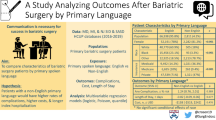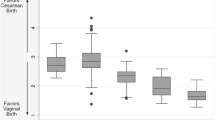Abstract
Objectives
While some medical indications for cesarean delivery are clear, subjective provider and patient factors contribute to the rising cesarean delivery rates and marked disparities between racial/ethnic groups. We aimed to determine the association between language preference and risk of primary cesarean delivery.
Methods
We conducted a retrospective cohort study of nulliparous, term, singleton, vertex (NTSV) deliveries of patients over 18 years old from 2011–2016 at an academic medical center, supplemented with data from the Massachusetts Department of Public Health. We used modified Poisson regression with robust error variance to calculate risk ratios for cesarean delivery between patients with English language preference and other language preference, with secondary outcomes of Apgar score, maternal readmission, blood transfusion, and NICU admission.
Results
Of the 11,298 patients included, 10.3% reported a preferred language other than English, including Mandarin and Cantonese (61.7%), Portuguese (9.7%), and Spanish (7.5%). The adjusted risk ratio for cesarean delivery among patients with a language preference other than English was 0.85 (95% CI 0.72–0.997; p = 0.046) compared to patients with English language preference. No significant differences in risk of secondary outcomes between English and other language preference were found.
Discussion
After adjusting for confounders, this analysis demonstrates a decreased risk of cesarean delivery among women who do not have an English language preference at one institution. This disparity in cesarean delivery rates in an NTSV population warrants future research, raising the question of what clinical and social factors may be contributing to these lower cesarean delivery rates.

Similar content being viewed by others
Data Availability
Deidentified datasets may be made available after written request to the corresponding author and pending any necessary institutional review board approval.
Code Availability
Data analysis was conducted using Stata v12.1 (StataCorp, College Station, Texas, 2018).
References
Admon, L. K., Winkelman, T. N. A., Zivin, K., Terplan, M., Mhyre, J. M., & Dalton, V. K. (2018). Racial and ethnic disparities in the incidence of severe maternal morbidity in the United States, 2012–2015. Obstetrics and Gynecology, 132(5), 1158–1166. https://doi.org/10.1097/AOG.0000000000002937
Alhusen, J., Bower, K., Epstein, E., & Sharps, P. (2016). Racial discrimination and adverse birth outcomes: An integrative review. Journal of Midwifery & Women’s Health, 118(24), 6072–6078. https://doi.org/10.1111/jmwh.12490
Bakken, K. S., Skjeldal, O. H., & Stray-Pedersen, B. (2015). Higher risk for adverse obstetric outcomes among immigrants of African and Asian Descent: A comparison study at a low-risk maternity hospital in Norway. Birth, 42(2), 132–140. https://doi.org/10.1111/birt.12165
Berdahl, T. A., & Kirby, J. B. (2018). Patient-provider communication disparities by limited english proficiency (LEP): Trends from the US medical expenditure panel survey, 2006–2015. Journal of General Internal Medicine. https://doi.org/10.1007/s11606-018-4757-3
Bohren, M. A., Hofmeyr, G. J., Sakala, C., Fukuzawa, R. K., & Cuthbert, A. (2017). Continuous support for women during childbirth (Review) summary if findings for the main comparison. Cochrane Database of Systematic Reviews. https://doi.org/10.1002/14651858.CD003766.pub6
Bryant, A. S., Washington, S., Kuppermann, M., Cheng, Y. W., & Caughey, A. B. (2009). Quality and equality in obstetric care: Racial and ethnic differences in caesarean section delivery rates. Paediatric and Perinatal Epidemiology, 23(5), 454–462. https://doi.org/10.1111/j.1365-3016.2009.01059.x
Carrasquillo, O., John Orav, E., Brennan, T. A., & Burstin, H. R. (1999). Impact of language barriers on patient satisfaction in an emergency department. Journal of General Internal Medicine, 14(2), 82–87. https://doi.org/10.1046/j.1525-1497.1999.00293.x
Divi, C., Koss, R. G., Schmaltz, S. P., & Loeb, J. M. (2007). Language proficiency and adverse events in US hospitals: A pilot study. International Journal for Quality in Health Care, 19(2), 60–67. https://doi.org/10.1093/intqhc/mzl069
Edmonds, J. K., Hawkins, S. S., & Cohen, B. B. (2014). The influence of detailed maternal ethnicity on cesarean delivery: Findings from the U.S. birth certificate in the State of Massachusetts. Birth (Berkeley, Calif.), 41(3), 290–298. https://doi.org/10.1111/birt.12108
Gemmill, A., Catalano, R., Casey, J. A., Karasek, D., Alcalá, H. E., Elser, H., & Torres, J. M. (2019). Association of preterm births among US Latina women with the 2016 presidential election. JAMA Network Open, 2(7), 1–10. https://doi.org/10.1001/jamanetworkopen.2019.7084
Getahun, D., Strickland, D., Lawrence, J. M., Fassett, M. J., Koebnick, C., & Jacobsen, S. J. (2009). Racial and ethnic disparities in the trends in primary cesarean delivery based on indications. American Journal of Obstetrics and Gynecology, 201(4), 422.e1-422.e7. https://doi.org/10.1016/j.ajog.2009.07.062
Grobman, W. A., Bailit, J. L., Rice, M. M., Wapner, R. J., Reddy, U. M., Varner, M. W., Thorp, J. M., Jr., Leveno, K. J., Caritis, S. N., Iams, J. D., Tita, A. T. N., Saade, G., Rouse, D. J., Blackwell, S. C., Tolosa, J. E., & Vandorsten, J. P. (2015). Racial and ethnic disparities in maternal morbidity and obstetric care. Obstetrics and Gynecology, 125(6), 1460–1467. https://doi.org/10.1097/AOG.0000000000000735
Hines, A. L., Andrews, R. M., Moy, E., Barrett, M. L., & Coffey, R. M. (2014). Disparities in rates of inpatient mortality and adverse events: Race/ethnicity and language as independent contributors. International Journal of Environmental Research and Public Health, 11(12), 13017–13034. https://doi.org/10.3390/ijerph111213017
Holmes, P., Oppenheimer, L. W., & Wu Wen, S. (2001). The relationship between cervical dilatation at initial presentation in labour and subsequent intervention. British Journal of Obstetrics and Gynaecology, 108(11), 1120–1124. https://doi.org/10.1016/S0306-5456(01)00265-0
Howell, E. A., Egorova, N. N., Janevic, T., Brodman, M., Balbierz, A., Zeitlin, J., & Hebert, P. L. (2020). Race and ethnicity, medical insurance, and within-hospital severe maternal morbidity disparities. Obstetrics and Gynecology, 135(2), 285–293. https://doi.org/10.1097/AOG.0000000000003667
Janevic, T., Loftfield, E., Savitz, D. A., Bradley, E., Illuzzi, J., & Lipkind, H. (2014). Disparities in cesarean delivery by ethnicity and nativity in New York city. Maternal and Child Health Journal, 18(1), 250–257. https://doi.org/10.1007/s10995-013-1261-6
John-Baptiste, A., Naglie, G., Tomlinson, G., Alibhai, S. M., Etchells, E., Cheung, A., Kapral, M., Gold, W. L., Abrams, H., & Bacchus, M. K. M. (2004). The effect of english language proficiency on length of stay. Journal of General Internal Medicine, 19(3), 221–228. https://doi.org/10.1111/j.1525-1497.2004.21205.x
Karliner, L. S., Kim, S. E., Meltzer, D. O., & Auerbach, A. D. (2010). Influence of language barriers on outcomes of hospital care for general medicine inpatients. Journal of Hospital Medicine, 5(5), 276–282. https://doi.org/10.1002/jhm.658
Kozhimannil, K. B., Hardeman, R. R., Attanasio, L. B., Blauer-Peterson, C., & O’Brien, M. (2013). Doula care, birth outcomes, and costs among medicaid beneficiaries. American Journal of Public Health, 103(4), 113–121. https://doi.org/10.2105/AJPH.2012.301201
Liu, S., Liston, R. M., Joseph, K. S., Heaman, M., Sauve, R., & Kramer, M. S. (2007). Maternal mortality and severe morbidity associated with low-risk planned cesarean delivery versus planned vaginal delivery at term. CMAJ, 176(4), 455–460. https://doi.org/10.1503/cmaj.060870
Louis, J. M., Menard, M. K., & Gee, R. E. (2015). Racial and ethnic disparities in maternal morbidity and mortality. Obstetrics and Gynecology, 125(3), 690–694. https://doi.org/10.1097/AOG.0000000000000704
Merry, L., Vangen, S., & Small, R. (2016). Caesarean births among migrant women in high-income countries. Best Practice and Research: Clinical Obstetrics and Gynaecology, 32, 88–99. https://doi.org/10.1016/j.bpobgyn.2015.09.002
Min, C. J., Ehrenthal, D. B., & Strobino, D. M. (2015). Investigating racial differences in risk factors for primary cesarean delivery. American Journal of Obstetrics and Gynecology, 212(6), 814.e1-814.e14. https://doi.org/10.1016/j.ajog.2015.01.029
Modest, A. M., Johnson, K. M., Karumanchi, S. A., Resetkova, N., Young, B. C., Fox, M. P., Wise, L. A., & Hacker, M. R. (2019). Risk of ischemic placental disease is increased following in vitro fertilization with oocyte donation: A retrospective cohort study. Journal of Assisted Reproduction and Genetics, 36(9), 1917–1926. https://doi.org/10.1007/s10815-019-01545-3
Ngo-Metzger, Q., Sorkin, D. H., Phillips, R. S., Greenfield, S., Massagli, M. P., Clarridge, B., & Kaplan, S. H. (2007). Providing high-quality care for limited english proficient patients: The importance of language concordance and interpreter use. Journal of General Internal Medicine, 22(SUPPL. 2), 324–330. https://doi.org/10.1007/s11606-007-0340-z
Osterman, M., & Martin, J. (2014). Trends in low-risk cesarean delivery in the United States, 1990–2013. National Vital Statistics Reports, 63(6), 1–16
Petersen, E. E., Davis, N. L., Goodman, D., Cox, S., Syverson, C., Seed, K., Shapiro-Mendoza, C., Callaghan, W. M., & Barfield, W. (2019). Racial/ethnic disparities in pregnancy-related deaths—United States, 2007–2016. MMWR Morb Mortal Wkly Rep, 68, 762–765. https://doi.org/10.15585/mmwr.mm6835a3
Rawal, S., Srighanthan, J., Vasantharoopan, A., Hu, H., Tomlinson, G., & Cheung, A. M. (2019). Association between limited english proficiency and revisits and readmissions after hospitalization for patients with acute and chronic conditions in Toronto, Ontario, Canada. JAMA—Journal of the American Medical Association, 322(16), 1605–1607. https://doi.org/10.1001/jama.2019.13066
Rowley, D. L., & Hogan, V. (2012). Disparities in infant mortality and effective, equitable care: Are infants suffering from benign neglect? Ssrn. https://doi.org/10.1146/annurev-publhealth-031811-124542
Sentell, T., Chang, A., Ahn, H. J., & Miyamura, J. (2016). Maternal language and adverse birth outcomes in a statewide analysis. Women & Health, 56(3), 257–280. https://doi.org/10.1080/03630242.2015.1088114
Stark, E. L., Grobman, W. A., & Miller, E. S. (2019). The association between maternal race and ethnicity and risk factors for primary cesarean delivery in Nulliparous women. American Journal of Perinatology. https://doi.org/10.1055/s-0039-1697587
Vadnais, M. A., Hacker, M. R., Shah, N. T., Jordan, J., Modest, A. M., Siegel, M., & Golen, T. H. (2017). Quality improvement initiatives lead to reduction in nulliparous term singleton vertex cesarean delivery rate. Joint Commission Journal on Quality and Patient Safety, 43(2), 53–61. https://doi.org/10.1016/j.jcjq.2016.11.008
Vedam, S., Stoll, K., Taiwo, T. K., Rubashkin, N., Cheyney, M., Strauss, N., McLemore, M., Cadena, M., Nethery, E., Rushton, E., Schummers, L., & Declercq, E. (2019). Giving voice to mothers: A participatory research study of mistreatment during pregnancy and childbirth in the United States. Reproductive Health, 16, 1–18
Zou, G. (2004). A modified poisson regression approach to prospective studies with binary data. American Journal of Epidemiology, 159(7), 702–706. https://doi.org/10.1093/aje/kwh090
Funding
This work was conducted with support from Harvard Catalyst | The Harvard Clinical and Translational Science Center (National Center for Advancing Translational Sciences, National Institutes of Health Award UL 1TR002541) and financial contributions from Harvard University and its affiliated academic healthcare centers.
Author information
Authors and Affiliations
Contributions
KMS, AMM, MRH, and RLM designed the study. KMS, AMM, MRH, LC, YC, TG, and RLM contributed to the acquisition, analysis, or interpretation of data. KMS drafted the manuscript. KMS, AMM, MRH, LC, YC, TG, and RLM provided substantive revisions and approval of the final manuscript.
Corresponding author
Ethics declarations
Conflict of interest
The authors report no conflict of interest.
Ethical Approval
This study was approved by the Institutional Review Boards of the Beth Israel Deaconess Medical Center and the Massachusetts Department of Public Health.
Consent to Participate
Participant consent was waived by the IRB.
Additional information
Publisher's Note
Springer Nature remains neutral with regard to jurisdictional claims in published maps and institutional affiliations.
Rights and permissions
About this article
Cite this article
Schaefer, K.M., Modest, A.M., Hacker, M.R. et al. Language Preference and Risk of Primary Cesarean Delivery: A Retrospective Cohort Study. Matern Child Health J 25, 1110–1117 (2021). https://doi.org/10.1007/s10995-021-03129-z
Accepted:
Published:
Issue Date:
DOI: https://doi.org/10.1007/s10995-021-03129-z




